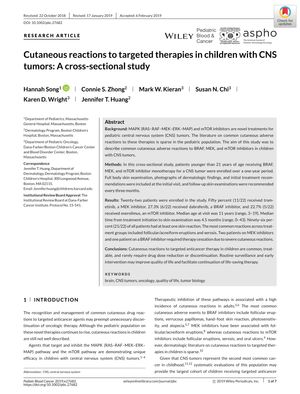TLDR Most children with CNS tumors on targeted therapy had skin reactions, which were generally treatable without stopping the therapy.
In a cross-sectional study involving 22 pediatric patients with CNS tumors undergoing targeted anticancer therapy, 96% experienced skin reactions, with follicular/acneiform eruptions and xerosis being the most common. Hand-foot syndrome was specifically linked to dabrafenib, while alopecia and paronychia were only seen with trametinib. Most skin reactions started within the first few weeks of treatment, and while skin-directed treatment was recommended for 63.6% of patients, with 75% showing improvement, only three patients had to discontinue therapy due to severe reactions. The study suggests that cutaneous side effects are common but manageable, and emphasizes the importance of skin surveillance and management to improve quality of life and maintain therapy continuity. It also indicates that younger patients might be more susceptible to eczematous reactions and less likely to develop cutaneous malignancies than adults. The findings highlight the need for larger studies to explore age-specific reactions and optimal treatment approaches.
10 citations
,
September 2016 in “Journal of cutaneous medicine and surgery” Patients on dabrafenib and trametinib for melanoma often experience skin side effects.
32 citations
,
May 2016 in “European journal of dermatology/EJD. European journal of dermatology” Targeted therapies for advanced skin cancer often cause hair and nail problems, which need managing to avoid changing the treatment dose.
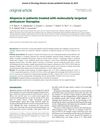 44 citations
,
September 2015 in “Annals of Oncology”
44 citations
,
September 2015 in “Annals of Oncology” Targeted cancer therapies have a significant but lower risk of causing hair loss compared to chemotherapy.
90 citations
,
August 2006 in “British Journal of Dermatology” PRIDE syndrome includes skin and hair issues from cancer treatment with EGFR inhibitors.
323 citations
,
November 1984 in “Journal of Investigative Dermatology”
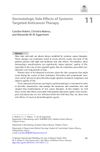 January 2018 in “Springer eBooks”
January 2018 in “Springer eBooks” Cancer treatments targeting specific cells often cause skin, hair, and nail problems, affecting patients' lives and requiring careful management.
86 citations
,
November 2020 in “Annals of Oncology” Early intervention and tailored management can reduce skin side effects from cancer treatments.
 4 citations
,
January 2016 in “Dermatology Review”
4 citations
,
January 2016 in “Dermatology Review” Cancer treatments often cause skin, nail, and hair problems.
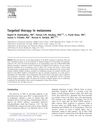 21 citations
,
February 2013 in “Clinics in Dermatology”
21 citations
,
February 2013 in “Clinics in Dermatology” New treatments for advanced skin cancer are improving patient outcomes, but drug resistance and finding the right treatment combinations are still big challenges.
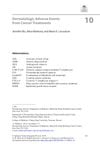 2 citations
,
October 2018 in “Springer eBooks”
2 citations
,
October 2018 in “Springer eBooks” Cancer treatments can cause skin-related side effects that may affect patient quality of life and require changes in treatment.
